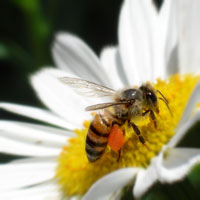
| Save the Bees - Sign the Petition! | 11 January 11 |
 A global petition is hoping to convince the US and EU to follow France, Italy, Slovenia, and Germany by banning neonicotinoid pesticides.
A global petition is hoping to convince the US and EU to follow France, Italy, Slovenia, and Germany by banning neonicotinoid pesticides.Neonicotinoids ("new nicotine-like things") are among the most widely used insecticides, and are used predominantly to coat seeds. Neonicotinoids persist in the soil, can harm airborne insects, soil organisms, and waterborne insects. Neonicotinoids are "systemic", which means that they do not simply sit on the plant's surface but are taken up into the plant, so the plant become toxic to feeding insects. Unfortunately, neonicotinoids are present in the pollen and nectar of flowers fed on by honeybees. Leaked U.S. Environmental Protection Agency (EPA) memos reveal the agency gave conditional approval to Clothianidin, a neonicotinoid based pesticides now in wide use, without requiring adequate proof that the chemical was safe to use around honeybees. EPA gave conditional approval in 2003, and allowed the chemicals to be sold, but told the manufacturing company, Bayer Crop Science, they needed to complete further safety testing regarding safety of use around honeybees. Bayer failed to do the testing for years, and instead sought and received an extension of the conditional permit to use the chemical. When Bayer finally performed the study, several deficiencies in conduct of the study were identified. EPA deemed the defective study acceptable and gave full registration to clothianidin in 2007. Globally bee numbers have been on the decline in recent years, with beekeepers losing 30 to 90% of their hives since 2006. This phenomenon is dubbed Colony Collapse Disorder (CCD). Multiple scientific studies identify neonicotinoids as contributing factor. Bees pollinate 90% of the plants we grow and deliver an estimated $40 billion in annual pollination services. European countries with neonicotinoids bans have seen improvements in bee populations. Sign Avaaz.org PetitionView November 2, 2010 EPA leaked Memo (PDF) View December 10, 2010 Fast Company article View December 14, 2010 Fast Company article View January 7, 2010 CommonDreams.org article View January 8, 2010 Huffington Post article View Manitoba Wildlands Biodiversity & Species page Sources: CommonDreams.org, EPA, Avaaz |
|
 Print version Print version |
Top |
